5 Easy Ways to Lose Weight in 30 DAYS
Check out my client Jordan’s transformation where he lost a whole lot of fat and maximized his gains by implementing the right diet and workout tips in his routine!
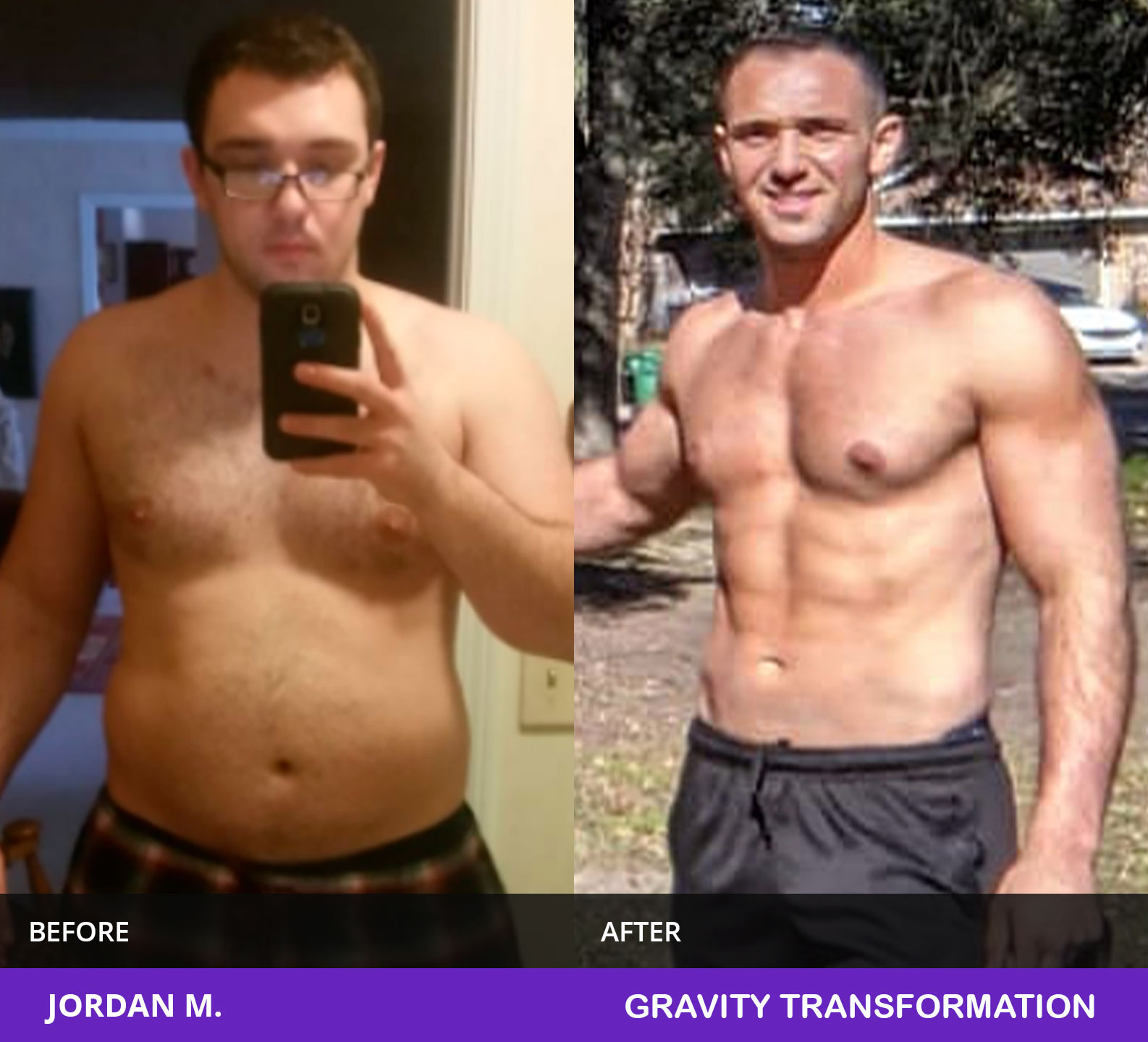
Learn the 5 Easy ways to lose weight & belly fat in just 30 days to see a flat stomach with abs.
You’ll start seeing results in as little as 2 weeks.
These are the best cyclical diet plans for weight loss to speed up losing inches and body fat without exercise.
Reduce your love handles and melt belly fat away overnight every night.
If you want to lose weight fast without being on a very restrictive boring diet plan, then you’re gonna love this post.
Most diet plans will require you to constantly keep your calories really low or to avoid carbs almost entirely.
Yet, there are a couple of dieting strategies that can get you to lose weight in a short amount of time without having to constantly starve yourself.
These are known as cyclical diet plans, and they have lots of unique advantages over regular dieting plans.

Today I want to go over the 5 most powerful cyclical diet plans that can really help to kickstart your weight loss. It’ll likely help even those of you that have already been dieting but still can’t shred that last bit of stubborn fat.
If you stick with me through this post, I can guarantee that not only will you learn something new, but also be able to take this information and apply it right away to see some results fast.
#1 Calorie cycling
This is the most basic form of cyclical dieting. Starting a diet normally begins by figuring out how many calories one should eat to create a deficit and lose weight.
A really easy way to do this is to multiply your body weight in pounds by 12, that should give you a pretty good starting point.
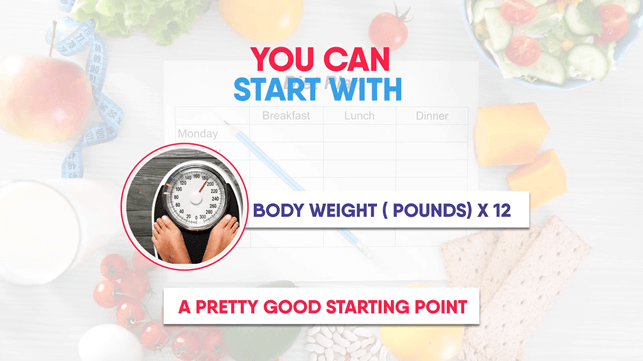
For example, let’s pretend that the number of calories that I need to eat to lose weight is 2,000 calories. And let’s say that my number to maintain my weight is 2500 calories.
With a regular calorie-restriction type diet, I’m cutting 500 calories per day. So after 7 days, I’ll wind up with a 3500 calorie deficit. This is how most people approach dieting.
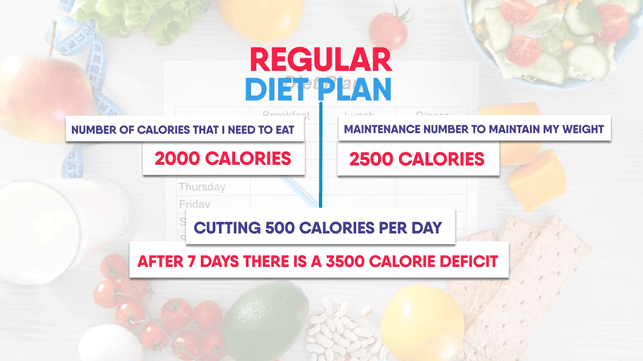
However, there’s another way where I can cycle my calories. Bear with me and follow the graph below for visual aid.
I might start with 1700 calories on day 1, then on day 2, I would have 2,000 calories. Then 2300, and maybe only 1500 calories for the next two days. Then 2000 calories and, finally, at the end of the week I could have a nice cheat day in which I eat 3000 calories.
If you add all of these numbers up and divide the total by 7, you can see that by the end of the week I would still be taking in an average of 2,000 calories per day.
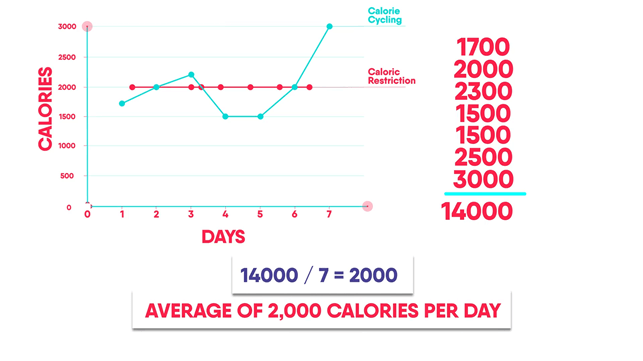
The reason why you might want to do this, instead of consistently sticking to 2,000 calories every day, is because cycling calories this way provides many benefits. And these can make for an overall better dieting strategy for you.
For example, some studies show that a calorie-cycling diet might not slow your metabolism the way that more traditional calorie-restriction diets would. Especially when done for longer periods.
This may help you keep the weight off better after you bring your calories back up.
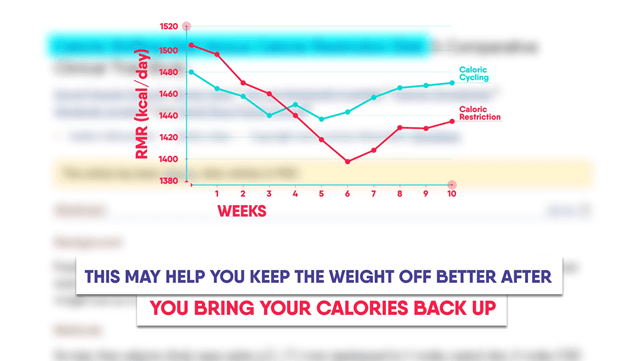
Another big benefit is that even though you’ll have to eat way fewer calories some days, on other days you’ll be able to eat many more calories. This allows you to have a break or a cheat day.
This really helps a lot of people stick to the plan because they have something to look forward to every week. And this may be why many studies show that cyclical diets have better adherence rates.
Sometimes the cycling calories study groups have less than half the number of dropouts, against the continuous calorie-restriction group.
Now, cycling your calories is the broadest form of cyclical dieting, which gives you plenty of options. You can go high-calorie one day, and low-calorie the next.
Or instead, you can have really high calories 1 week, and really low calories the next. As long as your totals balance out over time, it can work out just like a more continuous calorie-restriction diet.
#2 Cyclical ketogenic diet
A regular ketogenic diet requires you to keep your carbs very low.
And most plans will require you to only have about 5 percent of your daily calories from carbs. That usually amounts to less than about 30-50 grams of carbs per day.
Having such a small amount of carbs every day can be extremely challenging for most people to stick to. In addition, there are also drawbacks if you’re keeping your carbs really low for prolonged periods.

One of these drawbacks is thyroid issues. In fact, some studies show that carbohydrates may be essential for thyroid hormone metabolism.
If your thyroid isn’t working optimally, your weight loss will most likely stall.
Another drawback is around performance. There’s no denying that the ketogenic diet is very effective for weight loss.
But there’s also no denying that carbohydrates are very important for better performance, especially at high intensities.
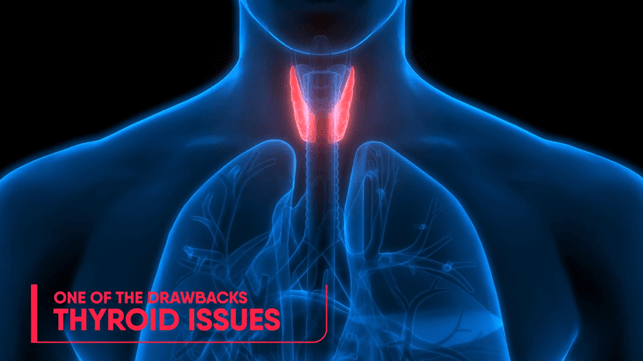
Studies show that people that have a moderate amount of carbs when dieting will be able to perform better at those higher intensities.
Heavy lifting while trying to lose weight isn’t only for your ego – it also helps you preserve muscle mass.
If you lose more muscle while cutting, you’ll also slow down your metabolism. This makes it harder to maintain that weight loss when you’re done with keto.

Another regular keto diet drawback is that you may not get enough fiber with it. This can lead to constipation and other digestive issues.
The cyclical ketogenic diet will help you avoid most of these issues. It will also decrease the early symptoms known as the “keto flu”.
You would do it by following the regular keto protocol for 5-6 days of the week. Then you would carb up 1-2 days per week.
This will temporarily knock you out of ketosis. But you’ll get right back into ketosis since you’ll be following the keto protocol around 90 percent of the time.
You can also try a targeted ketogenic diet, where you have 25-50 grams of carbs before your high-intensity workouts.
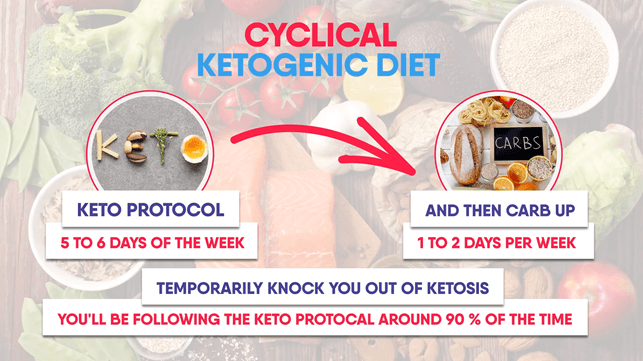
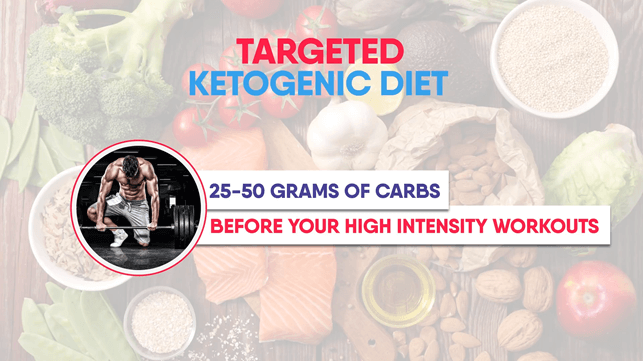
These alternative approaches will make sticking to the keto diet easier and could ultimately help you preserve more muscle mass.
Just keep in mind that if you’ve been on a very strict keto diet for a while, you’ll probably gain some water weight when reintroducing carbs.
Studies show that each gram of carbs is stored in your muscles with 3 grams of water. So be aware of that, but do remember that the whole point is fat loss rather than losing water weight.
Also be mindful that if you’re not having frequent intense training sessions throughout the week, you won’t be depleting enough carbs to get back into ketosis quickly.
In this scenario, a cyclical keto diet may not be the right choice. In this case, sticking to a regular keto protocol may actually work better.
Now, a lot of people think that this is the same as carb cycling, but it’s not. Let’s have a proper look into this one as the next weight loss method to see fast results.
#3 Carb cycling
Not only is carb cycling great for burning fat, but it’s also great for preserving strength and muscle mass.
It’ll also help you keep your performance levels high.
And reloading on carbs will assist with recovery since you’ll be replenishing your muscles’ glycogen stores.
Typically, a carb cycling diet will involve a couple of – high-carb days, moderate–carb days, and low–carb days.

An example would be 30 grams of carbs on your low–carb day; 100 grams on your moderate day; 250 grams on your high-carb day.
Your protein intake would remain consistent throughout the week. Also, on your lower-carb days you could choose to increase your fat intake to decrease hunger.

You would want to position your high-carb days around your intense workouts.
Some people will benefit more by “carbing” up the day before an intense workout. Others do better when they carb up on the same day as their intense workout.
If you work out first thing in the morning, I recommend that you place your high-carb day the day before. Whereas if you normally work out at night, then a high-carb day on the same day as your workout may work better.
Many people find it much easier to stick to a carb cycling diet, because they don’t feel sluggish and tired. Also, constantly being allowed to reload on carbs reduces your hunger, which makes the plan much less restrictive than most.
One study found that loading up on carbs, rather than fat, increased the participants’ resting metabolic rate. It also increased their leptin levels – a hormone released by fat cells that stimulates hunger suppression.
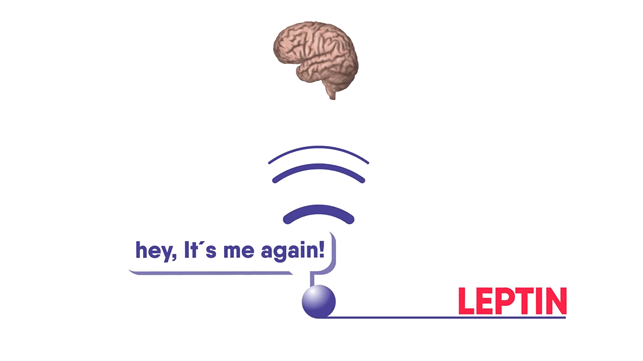

Cutting calories in any way will eventually slow your metabolism and cause weight loss to plateau.
We therefore want to keep that metabolism as high as possible while losing weight. Carb cycling could help us accomplish just that.
The best part is that even though you can eat a good amount of carbs on this type of diet, you still get many of the benefits that you would from a low-carb diet.
These include improved insulin sensitivity and faster fat loss.
#4 Alternate day fasting
The most basic form of alternate day fasting is done by fasting for 24 hours. Then eating freely for the next 24 hours.
Since you won’t ingest any calories on your fasting day, you get much more flexibility when you eat the following day.
Even though you can eat more calories than usual and be less restrictive with your meal options, it’s very important to remember that you can still overeat and slow fat loss.

That’s despite having fasted for a full 24 hours the day before. Remember all of these diet plans still require that your calories balance out at the end of the week.
A large Meta-Analysis compared alternate day fasting to a regular continuous low-calorie diet.
It showed that for many people alternate day fasting may be easier to stick to, results in greater fat loss, and less muscle loss.
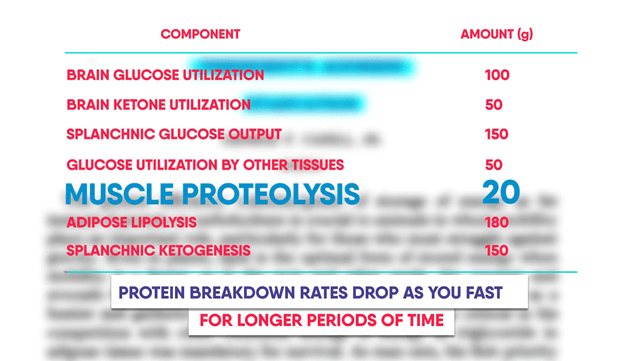
Another study found that protein breakdown rates drop as you fast for longer periods. This may be why there’s less muscle loss from alternate day fasting.
Now, I do have to mention that this diet won’t work for everyone. For some people not being allowed to eat anything for 24 hours can prove to be extremely difficult.
Even though studies show that alternate day fasting doesn’t have any negative effects on eating disorder symptoms, it could potentially lead some people to binge eating.
Luckily there is a way to ease your progression into this diet plan. And that’s by having a small 500-calorie meal on your fasting day.
Research supports this idea that having a small meal can make this diet much more sustainable in the long run.
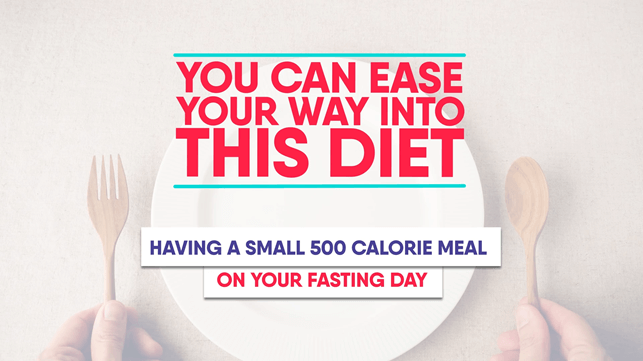
Does this plan sound still a little too challenging for you? If so, you’ll probably do much better with our final method to kickstart your fat loss.
You’ve most likely heard about it a lot lately – I’m talking about intermittent fasting.
#5 Intermittent fasting
This one is still a form of cyclical dieting because you’ll cycle between periods of eating and periods of fasting. The most common approach is the 16/8 method.
With this protocol, you would fast for 16 hours, and then limit your feeding window to only 8 hours.
Since you’ll most likely have to skip at least one meal, intermittent fasting allows you to have some more flexibility with your meal options, just like alternate day fasting.
However, it is a lot easier for many people to manage because you don’t have to fast for a full 24 hours. And you still get to eat large filling meals every day.
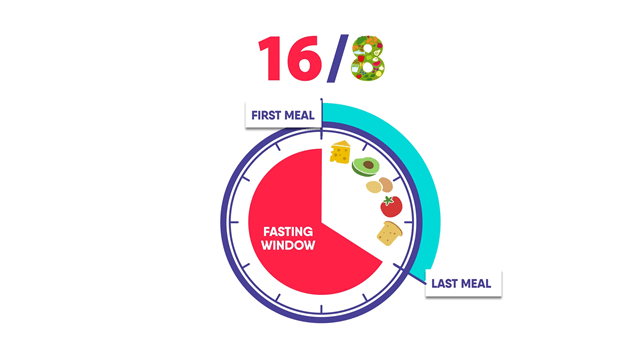
Large systematic reviews have shown that intermittent fasting is at least as effective as other continuous calorie-restriction diet plans for both fat loss and muscle preservation.
But because of intermittent fasting’s flexible nature, a lot of people prefer it over continuous energy restriction.
Again, with the 16/8 protocol, it’s important that you still eat mostly healthy foods during your eating window.
The plan will backfire if you eat tons of junk food, or simply overeat and end up taking in too many calories.
Concluding notes
That’s it for today guys. As always, I really hope this post has helped you out. Now, if you’re looking for a done-for-you approach to lose 20 pounds or 5 percent of your body fat in only 6 weeks, as it already has for so many of my clients, try my 6-week challenge.
In this program I go into much more detail on each of the 5 cyclical dieting plans that I talked about today, and it even includes a customized meal plan, a 42-day workout plan, and an accountability coach to guide you through the whole process.
The best part is that the challenge is free. But there is a catch – you have to stick to the plan.
The challenge is meant for people who are serious about making a transformation in the next 42 days. If you want more than just another diet and workout plan that you likely won’t commit to, then click the link below to find out more.
References
Calorie cycling vs continuous calorie restriction:
https://www.ncbi.nlm.nih.gov/pmc/articles/PMC4018593/
Thyroid issues occur if you restrict carbohydrates for too long:
https://www.ncbi.nlm.nih.gov/pubmed/7096916
Higher Carb diets stimulate More Muscle Protein Synthesis And Provide More Energy For High intensity activities when compared to higher fat diets:
https://www.ncbi.nlm.nih.gov/pubmed/10365988
https://www.ncbi.nlm.nih.gov/pubmed/7670450
Each gram of carbs will get stored in the muscles with 3 grams of water:
https://www.ncbi.nlm.nih.gov/pubmed/25911631
Metabolism and Leptin increases when Overfeeding on carbohydrates:
https://www.ncbi.nlm.nih.gov/pubmed/11126336
Meta Analysis on ADF Shows that compared to a continuous low calorie diet it may be easier to stick to, result in greater fat‐mass loss and less muscle loss:
https://www.ncbi.nlm.nih.gov/pmc/articles/PMC5043510/
Protein breakdown drops to 70g/24h when fasting and after fasting for 3-4 days drops further to only about 20g/24h:
https://www.ncbi.nlm.nih.gov/pmc/articles/PMC2279566/
ADF Does not lead to eating disorders:
https://www.ncbi.nlm.nih.gov/pmc/articles/PMC4424827/
Having a small meal makes ADF more sustainable:
https://www.ncbi.nlm.nih.gov/pubmed/15640462
Systematic review: Intermittent fasting just as effective as other diets for fat loss and muscle preservation:
https://www.ncbi.nlm.nih.gov/pubmed/26384657
My passion for fitness began when I was 14 years old. I naturally fell in love with training and haven’t stopped since. At 18 years I acquired my first personal training certification from ACE after which I opened my first of 3 transformation studios in 2011. I love to share my knowledge through personal training, my online courses, and youtube channel now with over 3,000,000 subscribers! I can happily say that we've helped over 15,000 people get in great shape over the years. I'm always here for my customers so if you need help don't hesitate to send your questions to support@gravitychallenges.com

